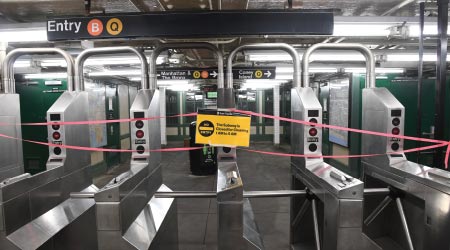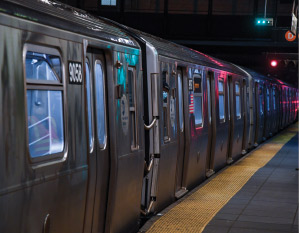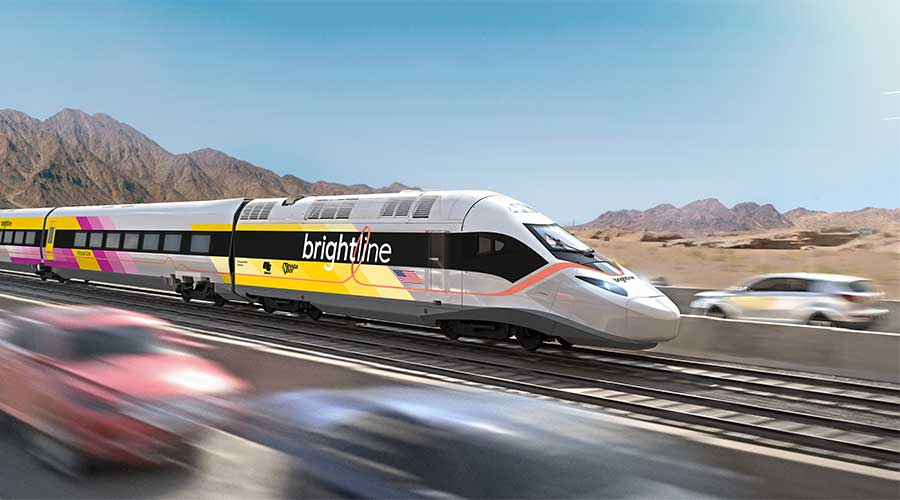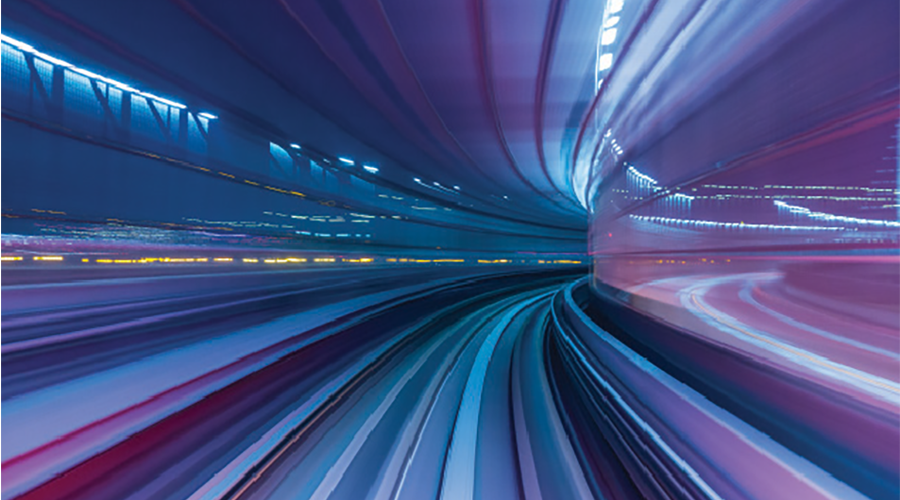Stay updated on news, articles and information for the rail industry
June 2020
Rail News: Passenger Rail
Confronting COVID-19: New York MTA, New Jersey Transit assess their human, financial costs

By Julie Sneider, Senior Associate Editor
By now, there’s no doubt the COVID-19 pandemic has taken a catastrophic human and financial toll on the U.S. public transportation industry. According to a recent economic analysis by EBP US Inc., the industry is expected to experience a $48.8 billion shortfall because of the pandemic.
Probably the most severely hit is the New York City/New Jersey region, home to two of the nation’s largest transit agencies: the Metropolitan Transportation Authority (MTA), which operates New York City Transit (NYCT), Long Island Rail Road (LIRR) and Metro-North Railroad; and New Jersey Transit.
At the MTA, the NYCT subway system is facing its worst financial crisis in decades, one anticipated to have a lasting impact on a city that has been at the epicenter of the nation’s coronavirus outbreak. As of May 4, ridership levels were down 92 percent on the subways, 95 percent on Metro-North, 97 percent on LIRR and 80 percent on buses. Bridge and tunnel crossings, which account for toll revenue losses, were down 62 percent, agency officials say.
As a result of the decrease in service, the MTA expects fare and toll revenue losses of up to $6 billion this year, with additional revenue losses anticipated in 2021. When lost revenue is combined with increased costs related to virus-related cleaning and sanitation practices, the MTA anticipates the full financial impact of the crisis to run $7 billion to $8.5 billion, even after the agency received $3.9 billion under the $2.2 trillion Coronavirus Aid, Relief and Economic Security Act (CARES) that Congress passed in March.
Meanwhile, NJ Transit’s ridership has been down more than 90 percent since the state’s coronavirus restrictions were enacted. The transit agency normally provides more than 925,000 weekday trips on its 253 bus routes, three light-rail lines, 12 commuter-rail lines and paratransit service. Rail ridership during the pandemic has been hit even harder than the other modes, sliding as low as 98 percent below normal, says Nancy Snyder, NJ Transit’s chief communications officer, who responded to questions via email.
“The financial impact will continue to escalate as we recover from this virus,” NJ President and Chief Executive Officer Kevin Corbett said May 12 during a press conference.
Taking a toll on employees
Then, there’s the heavy human toll. The agencies’ employees have been working on the front lines of the coronavirus since Day 1. As of mid-May, NJ Transit had lost 11 employees to COVID-19-related complications, including Raymond Kenny, senior vice president and general manager of rail operations. In addition, 519 employees had tested positive for COVID-19, with 306 having returned to work, said Snyder. Corbett himself tested positive for the virus, but continued to maintain his work schedule while isolating at home.
MTA Chair Patrick Foye also tested positive, telling local news media that he suffered a “mild case” of the disease in April. Others were not so lucky: As of May 20, 123 MTA employees died from complications of the virus, 1,273 were under quarantine and 3,883 had tested positive. All but three of the deaths were employees of NYCT. To assist deceased workers’ families, the MTA board approved a COVID-19 family benefits agreement with labor unions representing employees, and extended the agreement to non-represented employees. The benefits provide a payment of $500,000 to a spouse or beneficiary, in addition to providing health insurance for a spouse and dependent children.
MTA also established a “Resource Center” web page to help inform employees about COVID-19 facts, agency policies and guidelines, wellness and access to personal protective equipment (PPE) and a list of those employees who’ve died from COVID-19. As of mid-May, the agency had distributed 1.9 million masks and over 4 million pairs of gloves to workers across its system.
Also last month, MTA expanded its agreement with Northwell Health-GoHealth and BioReference Laboratories to provide coronavirus antibody testing to all MTA employees as part of Gov. Andrew Cuomo’s mandate to survey all essential workers. The lab has been testing employees at a number of MTA locations. Participation is voluntary and the test provided at no cost to the employee.
“Antibody testing is a critical tool for providing important health information to our employees and helping workers safely return to work in large numbers,” said Foye in a press release announcing the testing sites.
To help its employees, NJ Transit has maintained a sufficient inventory of PPE and a “healthy pipeline” for as long as necessary, Snyder said. Moreover, the agency has opened COVID-19 employee testing sites in East Rutherford, Gloucester County and Somerset.
Prior to the COVID-19 outbreak, both agencies had pandemic plans in place. NJ Transit drafted a comprehensive management plan (CEMP) in 2014, but on Feb. 6 agency leaders formed an internal coronavirus task force — led by the NJ Transit Police Department’s Office of Emergency Management — nearly a month before the first positive case was identified in New Jersey. The plan continues to be guided by state and federal health officials’ recommendations, she adds.
Over at MTA, Chief Safety Officer Pat Warren described in an email her agency’s pandemic plan is regularly updated with a “blueprint” that guides the agency’s response — in accordance with federal, state and local authorities’ orders — to quickly adapt to public health emergencies.
“The MTA has taken a number of aggressive steps to ensure worker safety, including reducing the number of crews that need to come in, implementing rear-door boarding to ensure social distance for bus operators, eliminating cash transactions, and disinfecting workplaces, trains, buses and all rolling stock, among other steps,” Warren said.

Unprecedented steps
Among those actions, two were unprecedented: The first occurred in early May, when NYCT began shutting down the subways overnight between 1 a.m. to 5 a.m. so that crews have more time to thoroughly clean and disinfect trains, stations and equipment. The policy, in place for the foreseeable future, is a first for the 115-year-old subway system.
MTA’s second unprecedented step is a pilot project, implemented in late May, that calls for the use of ultraviolet C (UVC) light technology to kill COVID-19 on subways, buses, stations and other NYCT facilities. UVC light has been used to kill viruses in other applications, including hospital operating rooms, urgent care clinics and fire stations, MTA officials say. The agency may expand the pilot to LIRR and Metro-North later this year.
The pilot was launched after MTA officials spent three months evaluating various approaches to improve cleaning and sanitizing of vehicles, facilities and equipment. The UVC effort is the first of MTA’s exploration of new options as it undertakes the largest cleaning and disinfecting regimen in MTA history during the overnight closures of the subway, agency officials say.
Although such measures improve the security of public transportation, they also also rack up additional costs during a period of stunning losses in revenue. NJ Transit, for example, estimates it’s incurring about $10 million a month in additional operating expenses for COVID-19-related safety precautions, while MTA says its related COVID-19 costs have been as much as $800 million. Although both agencies received billions of dollars in federal aid under the CARES Act — MTA was allocated $3.9 billion and NJ Transit, $1.5 billion — the funding has been used to maintain essential service levels for frontline pandemic workers to travel to their jobs.
While the CARES Act funding helped stop the agencies’ initial financial bleeding, it’s not enough for them to fully recover from the pandemic’s economic damage, both organizations say. Billions more in government aid will be necessary to ramp up service as millions of transit riders return to workplaces once restrictions are lifted. To that end, both MTA and NJ Transit are part of a coalition of the nation’s largest transit agencies asking Congress for an additional combined stimulus of $32 billion.
MTA has asked Congress for an additional $3.9 billion, which would take the agency through 2020, Foye said in a May 15 interview with WCBS 880. The agency normally earns 50 percent of its revenue from fares and tolls, he noted.
“Obviously, there’ll be additional amounts that we will need in 2021 because ridership is not going to go back to pre-pandemic levels immediately,” Foye added.
For its part, NJ Transit — which as of mid-May estimated the pandemic’s financial impact to the agency’s budget and finances will be $2.6 billion over the next 14 months — is seeking an additional $1.2 billion to plug the looming gap in its operating budget.
Looking toward recovery
As MTA and NJ Transit advocate for additional financial help from Congress, they’re also putting plans in place as the public and private sectors attempt to get back to some semblance of normalcy. In his May 13 letter to NJ Transit’s board and New Jersey Gov. Phil Murphy, Corbett noted that agency officials have turned their attention to recovery and ramp-up for life after the crisis, when workers in the New York-New Jersey return to reopened businesses.
Dubbing the return of regular service “NJ Transit: Your Ride to Recovery,” agency officials are working with MTA, the Port Authority-Trans Hudson rail service, Southeastern Pennsylvania Transportation Authority and Amtrak to ensure a coordinated restoration of transportation service, Corbett said. Simultaneously, an internal committee is working on recommendations for a structured “return to work” plan for NJ Transit employees.
NJ Transit leaders hope to drive a smooth transition for their own employees’ return to work, but they also appreciate the role the agency has in revving up the regional economy through a “robust capital program,” Corbett said.
As for MTA’s recovery, agency officials are drawing up a multilayered plan that includes safety procedures for riders and employees once the subways, commuter railroads and buses return to full service. The plan will require employees and riders to wear masks; employees’ temperatures to be taken daily; advancing disinfection techniques to a higher level; limiting the number of people allowed on train platforms at the same time; and applying other forms of social distancing.
To develop their transition-to-normalcy strategy, MTA officials have tapped outside sources for innovative ideas. They’ve studied how transit systems in Asia and Europe operated during and after coronavirus restrictions, and have talked with trade associations and technology companies, Foye said in the WCBS interview.
“The MTA is going to be as critical an agency in the recovery of New York City and [the] regional economy, which is about 10 percent of the national economy,” said Foye. “So, everything is on the table.”
Email comments or questions to julie.sneider@tradepress.com.


 Class Is Think Long-Term Intermodal Growth Despite Short-Term Turmoil
Class Is Think Long-Term Intermodal Growth Despite Short-Term Turmoil
 Introducing The Rising Stars Of 2025
Introducing The Rising Stars Of 2025
 2025 C&S Spending Report
2025 C&S Spending Report
 BNSF Forms Team Focused On Growing Single Carloads
BNSF Forms Team Focused On Growing Single Carloads
 railPrime
railPrime







